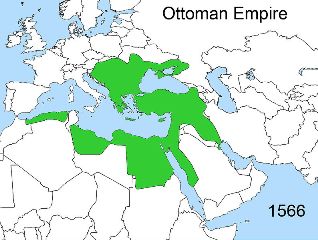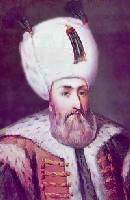History of Ottoman Empire
Learn about History of Ottoman Empire including a timeline, the capture of Constantinople, and leaders such as Suleiman, Osman, and Mehmed II
For more than 600 years, the Ottoman Empire dominated most of the Middle East and Eastern Europe. It was created in 1299 and eventually disbanded to become Turkey in 1923.
Rise of the Ottoman Empire
Osman I, the head of the Turkish tribes in Anatolia, established the Ottoman Empire in 1299. Osman I grew his empire and consolidated many of Anatolia’s separate nations under his control. Over the people he subdued, Osman imposed a formal administration and promoted religious tolerance.
 Map of the Ottoman Empire in 1566 by Esemono
Map of the Ottoman Empire in 1566 by Esemono
Capturing Constantinople
The Ottoman Empire grew during the ensuing 150 years. The Byzantine Empire was at the time the most powerful empire in the world (Eastern Roman Empire). Constantinople, the seat of the Byzantine Empire, was taken by Mehmet II the Conqueror and the Ottoman Empire in 1453. He renamed Constantinople Istanbul and made it the imperial capital of the Ottoman Empire. The Ottoman Empire would remain one of the biggest and most powerful empires in the world for the following several hundred years.
Many intellectuals and creatives emigrated to Italy after Constantinople was conquered by the Ottoman Empire. This played a role in igniting the European Renaissance. The European nations also started looking for new trade routes to the Far East as a result, ushering in the Age of Exploration.
Suleiman the Magnificent

Suleiman the Magnificent ruled during the Ottoman Empire’s height. From 1520 to 1566, he was in power. This period saw the empire grow and encompass a large portion of Eastern Europe, including Greece and Hungary.
Decline Ottoman Empire
In the late 1600s, the Ottoman Empire started to disintegrate. It stopped growing and started to experience economic rivalry from Europe and India. Up until the empire was dissolved and Turkey was proclaimed a republic in 1923, internal corruption and poor leadership caused a continuous deterioration.
Timeline of Ottoman Empire
- 1299 : The Ottoman Empire was started by Osman I.
- 1389 : Serbia is mostly conquered by the Ottomans.
- 1453 : The Byzantine Empire is overthrown as Mehmed II takes Constantinople.
- 1517 : Egypt is included into the Ottoman Empire after their conquest.
- 1520 : The Ottoman Empire is ruled by Suleiman the Magnificent.
- 1529 : The Vienna Siege.
- 1533 : Iraq is conquered by the Ottomans.
- 1551 : Libya is taken by the Ottomans.
- 1566 : Dieth Suleiman.
- 1569 : Istanbul is burning in a significant portion.
- 1683 : The Battle of Vienna results in the Ottomans’ defeat. This marks the start of the empire’s decline.
- 1699 : Austria gains control of Hungary from the Ottomans.
- 1718 : the start of the tulip era.
- 1821 : Beginning of the Greek War of Independence
- 1914 : In World War I, the Ottoman Empire joins the Central Powers.
- 1923 : The Republic of Turkey is established as a nation after the dissolution of the Ottoman Empire.
Religion
In the Ottoman Empire, religion was significant. Despite being Muslims themselves, the Ottomans did not compel the populations they subdued to become Islam. They did not forbid Christians or Jews from practicing their religion. As a result, they were able to govern for such a long time and prevent the people they had subjugated from rising up.
The Sultan
The Sultan was the title given to the ruler of the Ottoman Empire. The eldest son received the title of Sultan. When a new Sultan came to power, he would imprison all of his brothers. He would have his brothers put to death once he had a son of his own to take the throne.
Facts about the Ottoman Empire
- The Topkapi Palace in Istanbul was the home of the Sultan and his numerous wives. Because he was afraid of being killed, the Sultan would change rooms in the palace every night.
- All Muslims looked to Suleiman the Magnificent as their earthly leader. The Ottomans dubbed him “The Lawgiver.”
- Revolutionary Kemal Ataturk formed the Republic of Turkey.
- The Sultan’s elite warriors were known as Janissaries. These troops were chosen at a young age from Christian households. Despite being treated nicely and receiving a consistent pay, they were regarded as slaves.
- The Ottoman Empire’s arts blossomed during the peaceful Tulip Age. The perfection and beauty of tulips were represented by them.
Read also : Elizabethan Era
 The First Encyclopedia Your First Knowledge Home
The First Encyclopedia Your First Knowledge Home
